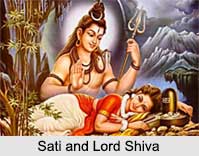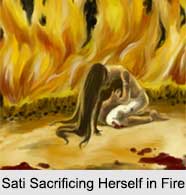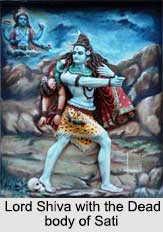 Legend of Sati narrates the tale of the marriage of Sati with Lord Shiva and it also connects itself to the chief of gods, named Daksha. Both Sati and Parvati, consecutively play the role of bringing Lord Shiva away from ascetic separation into original participation with the humanity in Hindu myth. Sati is also known as "Dakshayani" who is a Hindu Goddess.
Legend of Sati narrates the tale of the marriage of Sati with Lord Shiva and it also connects itself to the chief of gods, named Daksha. Both Sati and Parvati, consecutively play the role of bringing Lord Shiva away from ascetic separation into original participation with the humanity in Hindu myth. Sati is also known as "Dakshayani" who is a Hindu Goddess.
Myths of Sati
In Hindu mythology, Sati was the daughter of King Daksha, son of the Hindu creator Lord Brahma. King Daksha married Prasuti, the daughter of Sage Manu and she bore him sixteen daughters, of whom the youngest, Sati, became the wife of Lord Shiva. This was an unpleasing according to her father, for he had a grudge against Lord Shiva. Sati set her heart on Lord Shiva and worshipped him in secret.
 For her marriage, her father held a "swayamvara", or own-choice and he invited gods and princes from far and near, except Lord Shiva. Then Sati was borne into the great assembly, wreath in hand. She cast her wreath into the air in despair by calling upon Lord Shiva to receive the garland because Lord Shiva was not there. Then Lord Shiva stood in the middle of the court with the wreath about his neck. King Daksha had then no choice but to complete the marriage and Lord Shiva went away with Sati to his home in Kailasa. This Kailasa was far away beyond the Himalayas and there Lord Shiva dwelt in royal state, worshipped by gods and sages.
For her marriage, her father held a "swayamvara", or own-choice and he invited gods and princes from far and near, except Lord Shiva. Then Sati was borne into the great assembly, wreath in hand. She cast her wreath into the air in despair by calling upon Lord Shiva to receive the garland because Lord Shiva was not there. Then Lord Shiva stood in the middle of the court with the wreath about his neck. King Daksha had then no choice but to complete the marriage and Lord Shiva went away with Sati to his home in Kailasa. This Kailasa was far away beyond the Himalayas and there Lord Shiva dwelt in royal state, worshipped by gods and sages.
King Daksha made arrangements for a great horse sacrifice and invited all the gods but he did not invite Lord Shiva. The chief offerings were to be made to Lord Vishnu. Sati, wife of Lord Shiva, observed the departure of the gods, as they set off to visit King Daksha. She asked Lord Shiva about the matter.  Then Lord Shiva told Sati that King Daksha had prepared for a horse sacrifice and the gods are being invited to attain it. Lord Shiva also replied to Sati that it was planned among the gods. Sati became very angry and asked what she could do for him so that Lord Shiva gets the share of the offerings in great horse sacrifice. Then Lord Shiva smiled and told to Sati that those sacrificial offerings were of less importance to him and he gets the sacrifices easily when one chants the hymns of "Samaveda". His priests were those who present the oblation of true wisdom, where no officiating Brahmin was needed. Then she took permission to visit the horse sacrifice of King Daksha. Lord Shiva then enquired if she would visit without invitation and then Sati replied that in order to go to a father`s house no invitations were required. Thus Sati took permission from Lord Shiva and started for her father`s home.
Then Lord Shiva told Sati that King Daksha had prepared for a horse sacrifice and the gods are being invited to attain it. Lord Shiva also replied to Sati that it was planned among the gods. Sati became very angry and asked what she could do for him so that Lord Shiva gets the share of the offerings in great horse sacrifice. Then Lord Shiva smiled and told to Sati that those sacrificial offerings were of less importance to him and he gets the sacrifices easily when one chants the hymns of "Samaveda". His priests were those who present the oblation of true wisdom, where no officiating Brahmin was needed. Then she took permission to visit the horse sacrifice of King Daksha. Lord Shiva then enquired if she would visit without invitation and then Sati replied that in order to go to a father`s house no invitations were required. Thus Sati took permission from Lord Shiva and started for her father`s home.
When Sati arrived at the place of great horse sacrifice, she was received but without honour. She rode on the bull of Lord Shiva and wore a beggar`s dress. She protested against her father`s abandon of Lord Shiva, but King Daksha broke into anger and insulted Lord Shiva. Unable to persuade her father to invite her husband, Sati threw herself into the sacrificial fire and burned to death. Lord Shiva then took Sati`s body from the flames in anger and sadness and started Tandava with it. His violent dance threatened to demolish the whole universe. Finally, Lord Vishnu cut Sati`s body into pieces, and Lord Shiva ended his dance. All these places are known as holy 52 Shakti pithas in Hinduism. Lord Shiva returned to Mount Kailasa to meditate and mourn his wife"s death. Goddess Sati eventually returned to Lord Shiva by taking birth as Parvati. According to some versions of the story, Lord Vishnu later brought Sati back to life.




















